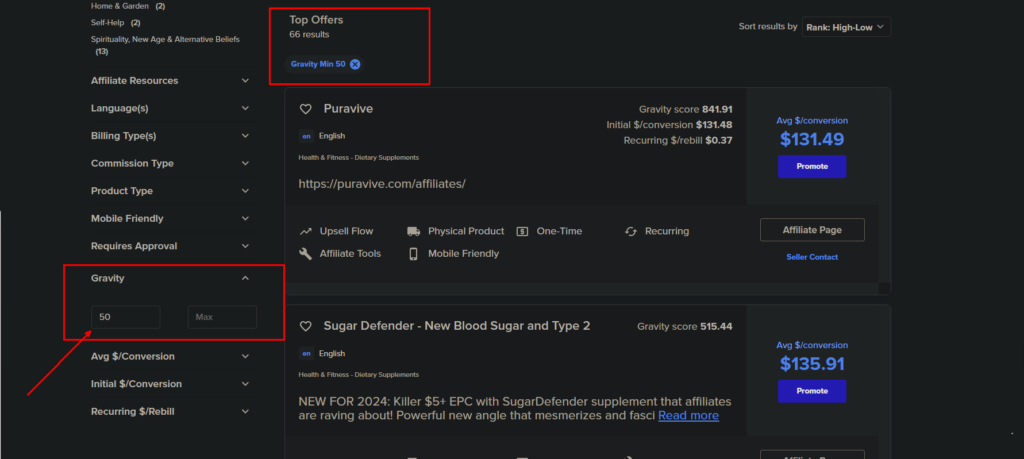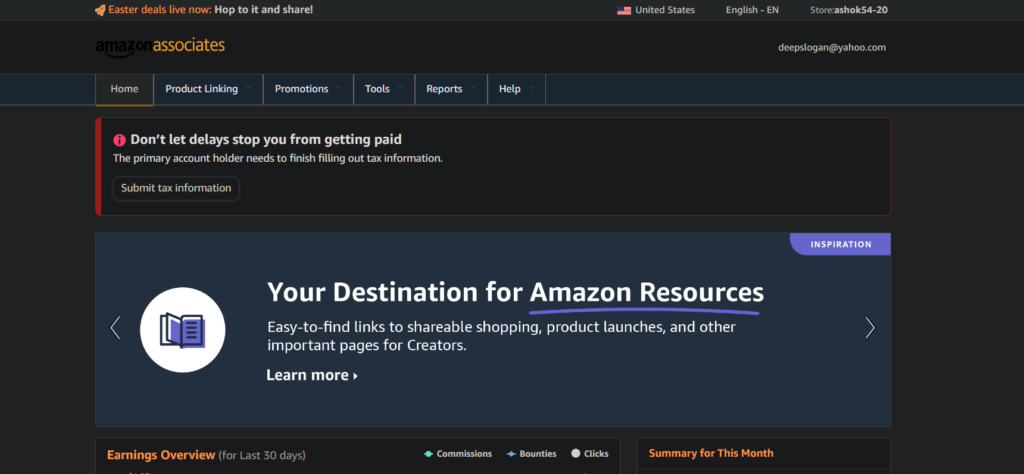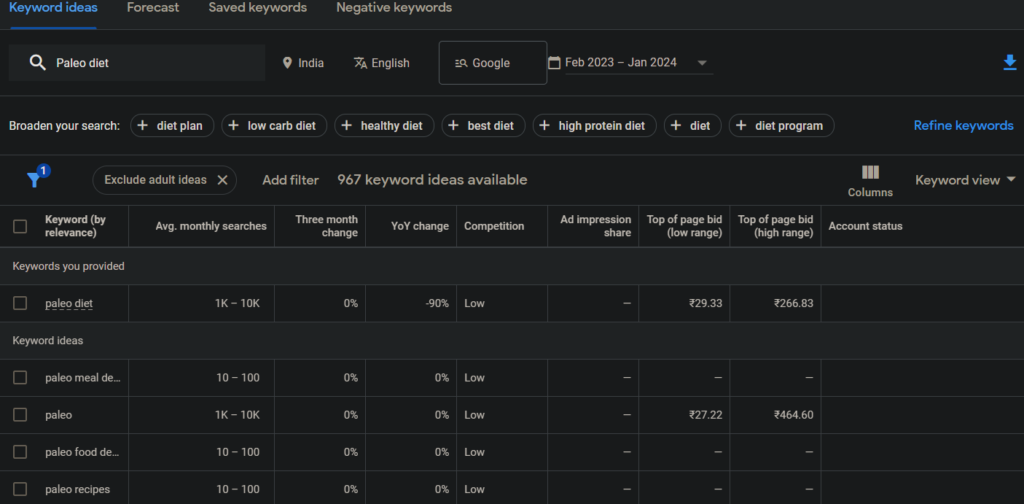Introduction
Affiliate marketing has become an extremely popular way for bloggers and website owners to monetize their content by earning commissions from sales they refer to other companies. As an affiliate marketer, choosing the right niche is absolutely critical for your success. If you identify and dominate a truly profitable affiliate niche, you can build a sustainable business that earns great commissions month after month.
“If you want to succeed in affiliate marketing over the long-term, forget about promoting random products – you need to become a niche expert.” – Adarsh Ak, Passionate Blogger

On my website, www.passionate-blogger.com, I share tips on affiliate marketing from my own experience as a full-time affiliate over the past 5 years. In that time, I have tested many different niches and offers before finding the optimal approach.
There are several excellent tools available today that make it much easier for an affiliate marketer to analyze markets and identify the most lucrative niches to focus on. In this article, I will outline the top tools that every affiliate should be using as part of their niche research.
| Tool | Key Benefit |
|---|---|
| Google Trends | Analyze search volume and trends over time for niche keywords |
| ClickBank Marketplace | Identify top-selling affiliate offers and products |
| Amazon Associates | View bestseller rankings by category to spot trends |
The key things I look for when researching a potential profitable niche are:
- Rising consumer demand and interest over time
- Enough search volume and audience size to be sustainable
- Reputable affiliate programs that pay high commissions
- Reasonable competition levels
By leveraging the right tools to conduct thorough niche research before promoting any affiliate offers, your chances of success in this industry will skyrocket. The tools outlined in this article have been indispensable for me in identifying several extremely profitable niches that have taken my affiliate marketing business to the next level over the last few years. I hope they can help you find your perfect niche as well!
Using Google Trends to Research Affiliate Niches
Google Trends should be the first tool an affiliate marketer turns to when researching new niche ideas. As one of the world’s leading search engines, Google has access to massive amounts of data on consumer search behavior and trends over time. Leveraging these insights can reveal extremely lucrative opportunities for affiliate marketing.
Specifically, Google Trends allows you to:
- Track search volume data for keywords over any time period you define – by month, year etc. This is invaluable for spotting emerging trends and opportunities.
“We analyze search data in Google Trends when identifying potentially hot affiliate niches to target. It really helps you gauge consumer interest and demand.”
- Compare search volume between different terms/topics to see which are gaining more traction among audiences. The year-over-year growth rates highlight rising affiliate niches.
- Identify seasonal spikes for particular keyword groups. This indicates opportunities to promote relevant affiliate products around holiday sales etc.
- Break down search data by country and even state. This allows you to niche down and focus your affiliate sites on particular target geographies.
| Keyword | Avg. Monthly Searches | Growth (YoY) |
|---|---|---|
| keto recipes | 90,500 | +25% |
| meditation for beginners | 72,000 | +15% |
For instance in the table above, we can see that interest in the keto diet is rising rapidly based on above average search growth. This presents an opportunity to create affiliate sites targeting this niche.
So, regularly analyzing keyword data in Google Trends is crucial to spot the next big affiliate marketing niche before your competitors. You can identify rising consumer demand, seasonal sales spikes, and geographic variances in search behavior. Combine it with website analytics data, and you have a very powerful toolset to identify the most profitable niches to target with affiliate sites and start driving commissions!

Using ClickBank to Identify Profitable Affiliate Niches
Another excellent tool for researching lucrative affiliate marketing niches is ClickBank. As one of the largest affiliate networks, ClickBank allows you to browse and filter thousands of affiliate offers across almost every category imaginable.
The key benefit of using ClickBank for niche research is gravity scores. This proprietary metric indicates the number of affiliates who have earned a commission promoting a particular offer over the last 8 weeks.
Simply put, the higher the gravity score, the more money affiliates are making from that offer.
“We filter ClickBank categories by gravity score to quickly identify offers in profitable niches that are converting well for affiliates.”
Here’s a quick 3 step process for using ClickBank to find profitable niches:
- Browse categories related to your interests and identify offers with gravity scores above 50+
- Take note of the overall niche/topic of the top offers as they reveal rising trends
- Search for related keywords in Google Trends to analyze search volume and growth
For example, in the cooking niche some offers with high gravity scores recently include:
- Paleo cookbooks
- Keto diet recipes
- Instant pot cookbooks
This signals that diet and specialty cooking niches are resonating well with audiences and converting for affiliates.
So regularly analyzing top offers in ClickBank by gravity score allows you to spot lucrative affiliate niches others may be missing. You can then leverage these insights in conjunction with other tools like Google Trends to validate and further research consumer demand before targeting the niche.

Using Amazon Associates to Identify Trending Affiliate Products
In addition to ClickBank, Amazon Associates is an indispensable tool for spotting the latest trends across affiliate niches. As the world’s largest online retailer, Amazon has its finger on the pulse when it comes to rising popularity of products that align to various niches.
Here are some of the key ways Amazon Associates can help identify potentially hot offers to promote as an affiliate:
Monitor Best Sellers Lists
Amazon breaks down best selling products across every major category and niche. You can browse categories related to your interests and identify rising stars.
For example, some current fast selling products in the gardening niche include:
- Compost bins
- Raised garden beds
- Soil test kits
This signals a trend around more people taking up gardening and looking to be self-sufficient. Promoting relevant affiliate products in this niche could be very lucrative right now.
New Product Releases
You can also browse new product releases on Amazon and spot affiliate opportunities before others. Getting in early with promotions when products first launch can help you seize a niche.
Review Search Data
Analyze search volume and trends for product keywords in Google Trends to gauge consumer demand. Compare that with Amazon’s sales data and best seller rankings to make informed niche decisions.
By regularly analyzing Amazon Associates data combined with your own keyword research, you will be well equipped to identify the most profitable and promising affiliate niches to target right now.

Leveraging Affiliate Marketing Forums for Niche Research
While tools like ClickBank and Google Trends should form the foundation of your affiliate niche research, I also highly recommend tapping into affiliate marketing forums.
Connecting with other experienced affiliates can provide invaluable insights directly from the front lines of niche profitability. Here are some of the key benefits of leveraging forums:
Get Niche Suggestions
Browse through forum threads and pay attention to what niche ideas seasoned affiliates are discussing. If multiple affiliates highlight interest and success in a particular niche, dig deeper.
For example, recently one of the hottest niches according to posts has been promoting eco-friendly, sustainable products. This includes solar panels, composting supplies, eco-friendly cleaning products etc.
Learn What Offers Convert
You can also often find forum threads where affiliates share details of offers that are generating good commissions across different niches. This real-world conversion data is like gold for spotting profitable opportunities before diving in.
Some offers getting recent praise from affiliates include:
- DIY home solar panel kits
- Organic mattresses
- Reusable storage bags
Connect with Niche Experts
Participate in forum discussions and build connections with affiliates already succeeding in your desired niche. Reach out over direct message as well to further pick their brains and learn what is working for them. These niche experts can fast track your success.
In summary, affiliate marketing forums represent a treasure trove of on-the-ground intel for identifying breakout affiliate niches. Combine these community insights with broader market research for a winning approach.
Evaluating Merchant Affiliate Pages for Niche Ideas
A little known yet extremely effective tactic for identifying profitable affiliate marketing niches is to analyze what offers merchants themselves are pushing to their affiliate partners.
As an affiliate, you can browse affiliate network sites like ClickBank, shareASale, Pepperjam etc. and filter by specific advertisers that interest you.
Once you click through to an advertiser’s affiliate page, pay attention to:
Top Converting Offers
Reputable merchants will often showcase the specific offers, products or campaigns earning their affiliates the highest commissions. If certain offers are highlighted, it signals that they have traction.
For example, a leading natural supplement brand recently highlighted on their affiliate page that their top converting offer was a bundle deal for men over 50. This immediately gives me an interesting niche to explore.
Product Categories
Merchants will also call out specific categories within their product line as outperforming for affiliates. This helps you niche down and focus your efforts on what’s already working.
So if a merchant has hundreds of supplements but specifically guides affiliates towards their weight loss and fitness products, you have very actionable intel.
Exclusive Assets
Sign up as an active affiliate partner to gain access to insider data on top offers, custom banner ads and creatives, promo codes and deals to feature, dedicated affiliate manager contacts and more.
So that, evaluating advertiser affiliate pages provides invaluable top-down perspective into the most lucrative niches and offers to promote across various affiliate programs.
Leverage Google Keyword Planner for Niche Research
While Google Trends allows you to analyze search volume data and identify breakout niches, Google’s free Keyword Planner tool provides additional capabilities to assess niche viability.

Specifically, Keyword Planner gives you metrics like:
- Exact monthly search volume for the keywords you input rather than indexed scores in Trends
- Competition levels – low, medium, high competition
- Suggested bid prices
Here are some of the ways affiliates can leverage Keyword Planner for profitable niche identification:
Validate Search Volume
Take potential niche keyword ideas from other tools and input them into Keyword Planner to get precise search volumes. This helps you quantify market size and commercial intent.
For example, “vegan protein powders” shows 2,400 global monthly searches – a strong mid-tail keyword for a niche site.
Assess Competition
Keyword Planner displays competition levels for keywords which indicates how saturated niches are. Look for niche keywords marked as low or medium competition.
Find Long-Tail Variations
The related keywords and search query data reveals fresh long-tail keyword opportunities with lower competition and decent search volume. Uncovering these is key for an SEO-focused affiliate site.
In summary, complementing broader niche research in Google Trends with precise data from Keyword Planner provides well-rounded confirmation of a niche’s profitability potential for affiliate marketing.
Leveraging Social Media for Niche Research
With billions of users across platforms like Facebook, Instagram, YouTube and TikTok, social media represents a goldmine for affiliate research.
Here are some of the key ways affiliates can leverage these platforms to unlock lucrative niches:
Identify Influencers
Use tools like BuzzSumo or Simple Scraper to identify influencers with engaged audiences in your desired niche. Reach out to them about potential collaborations promoting relevant affiliate products.
For example, fitness influencers with hundreds of thousands of followers are great partners for supplements and workout gear offers.
Analyze Affiliate Activity
Pay attention to the offers you see influencers and niche-relevant brands promoting on their social channels through links, promo codes etc. This real-world data reveals what’s gaining traction.
Tap Into Existing Communities
Engage in popular niche-specific groups on Facebook, Subreddits etc. to take the pulse of what people are talking about. The collective conversations highlight opportunities.
Uncover Trending Topics
Use hashtags and search to uncover trending topics and emerging trends in your niche. The viral spread of social content hints at affiliate potential before mainstream discovery.
So, You have to actively listening to niche-relevant social media conversations allows you to gain an authentic understanding of people’s interests and pain points. This ensures you promote offers that truly deliver value.
Utlize SEO Tools for Competitive Analysis
While the previous tools allow you to spot emerging affiliate niches and trends, SEO tools help assess how competitive those niches are online.
Thorough competitive analysis ensures the niche and target keywords you identify are truly viable to rank well for over the long-term. This leads to sustained organic traffic and conversions.
Here are some of the key ways SEO tools enable proper niche evaluation:
Keyword Research
Use Ahrefs, SEMrush, or Ubersuggest to research niche site ranking factors like:
- Keyword difficulty scores
- Domain authority of current top pages
- Backlink profiles
Filter for mid-high search volume keywords that have relatively low competition. This strikes the ideal balance for profitability.
Topic Analysis
SEO tools also help you research and compare the broader performance for topics and niches. Metrics like search volume, cost per click, and ad competition indicate commercial viability.
Site Audit Features
Audit existing niche sites you may consider acquiring to evaluate their organic presence. Analyze the backlink profile, on-page optimization, page speed etc. to value the asset.
| Metric | Ideal Range |
|---|---|
| Keyword Difficulty | 0-50 |
| Domain Authority | 30+ |
| Search Volume | 500-5,000 |
Note : Applying SEO tools takes niche affiliate research to the next level for determining true ranking potential and long-term viability. Don’t just rely on demand signals – evaluating the competitive landscape is critical for sustained success.
Conclusion – Key Takeaways for Profitable Niche Research
If you want to achieve long-term success as an affiliate marketer, identifying and dominating a truly profitable niche is absolutely essential. Simply promoting random products without focus will not lead to sustainable earnings. The key is thorough research before committing to any niche.
Throughout this guide, we have explored the top tools and strategies for niche analysis from multiple angles:
Validating Search Volume and Demand
Leverage Google Trends, Keyword Planner, and social media to quantify search volume over time. This ensures there is sufficient commercial intent and audience interest to profit from.
Spotting Trends and Rising Affiliate Opportunities
Monitor platforms like ClickBank, Amazon, and forums to uncover breakout offers and products gaining traction. Move quickly to capitalize before niches become oversaturated.
Assessing Keyword and Site Competition
Use SEO tools to analyze domain authority, backlinks, and other ranking factors. Choose niche target keywords based on difficulty scores and optimization potential.
Evaluating Affiliate Program Terms
Vet advertiser commission rates, cookie duration, payment reliability etc. Choose programs that align well with niche profitability.
| Research Area | Key Tools |
|---|---|
| Search Volume | Google Trends, Keyword Planner |
| Product Trends | ClickBank, Amazon, Forums |
| SEO Competition | Ahrefs, SEMrush, Moz |
In summary, finding a truly profitable affiliate niche requires analyzing potential opportunities from multiple lenses using the tools and strategies outlined above. Only with thorough research upfront can you set your sites up for long-term organic growth, traffic, and affiliate earnings.
FAQs
Q1. What are the most important factors to consider when trying to find a profitable niche?
The main factors are search volume/demand, competition levels, commercial intent, affiliate program commission rates, and audience engagement for the niche topic. Do thorough research on all fronts before committing.
Q2. Why is it better to focus on a niche instead of promoting a variety of random products?
Niching down allows you to really understand your target audience pain points and interests. You can then provide focused solutions through your affiliate promotions rather than scattershot recommendations. It also helps you rank better long-term.
Q3. What search volume should I target for affiliate niche keywords?
Look for at least 500-5000 monthly searches for primary keywords, while mining for long-tail variations with 100+ searches. Ensure there is growing search volume potential.
Q4. How do I assess competition levels for an affiliate niche?
Use SEO tools like Ahrefs and SEMrush to analyze domain authority, backlinks and keyword difficulty scores of existing sites ranking well. Find niches where you can realistically compete.
Q5. What makes an affiliate program suitable for a niche?
Consider commission rate, cookie duration, payment reliability, promotional resources and if they offer recurring commissions or bonuses for top affiliates in determining fit.
Q6. Why is it important to differentiate in competitive niches?
In crowded markets, build niche sites that stand out through excellent content, product comparisons and SEO optimization. This wins you loyal traffic rather than being a copycat site.
Q7. What metrics indicate an engaged niche audience?
Look for active online communities, comments and social shares around content in the niche. This shows people have a vital interest and are motivated to buy solutions.
Q8. How can I connect with influencers in my chosen niche?
Use BuzzSumo to identify relevant influencers by search terms. Reach out to collaborate on content promotions. Having influencer endorsements lends credibility.
Q9. What tools are best for initial niche demand research?
Start with Google Trends and Keyword Planner to analyze search volumes over time. Then use ClickBank gravity scores and Amazon best sellers for product fit.
Q10. Why research beyond demand for the niche?
Vetting aspects like competition, affiliate programs, social engagement etc. ensures you make data-backed decisions before investing time and money into a niche site.
Q11. What niche research should I do before promoting offers?
Proper validation ensures you pick profitable offers actually aligned to audience interests. Don’t randomly promote products without understanding the niche landscape.
Q12. How often should I revisit niche research after launching a site?
Conduct light ongoing research every quarter to spot emerging trends, new affiliate programs and monitor search volume shifts to keep your site aligned with niche profitability.
Q13. What tools provide the best affiliate program research?
ShareASale and ClickBank allow deep filtering into advertisers, commission rates, offers etc. CJ Affiliate Conversations surfaces insider affiliate discussions.
Q14. Can I succeed with a broad niche site?
It’s best to start laser focused on a sub-niche before expanding scope. Prioritize authority on a niche topic vs. diluting efforts across disparate content.
Q15. What does “long-tail” mean in niche research?
Long-tail refers to very specific, low competition keyword variations with decent search volume. Include these for search diversity and increased rankings. Long tail keywords ensures more ranking success in affiliate marketing!
Q16. What is the best way to validate niche demand from search results?
To find a niche and validating it, you need to use tools like Google Keyword Planner and Google Trends to analyze exact search volumes and growth trends over time. This quantifies interest and commercial search results potential.
Q17. How can I predict “hot” future niches for affiliate sites?
Look for rapidly rising searches around new technologies, strong early social media buzz for new products/services, and consumer shifts like sustainability. Move quickly!
Q18. What defines a “good” affiliate for advertisers?
Key attributes include an engaged email list or website traffic in their niche for affiliate marketing, strong content and SEO skills, and a track record of promoting offers ethically to get conversions.
Q19. How does affiliate marketing tie into broader digital marketing?
Affiliate partnerships and organic traffic to money sites from SEO support each other. Use affiliate earnings to reinvest in content and traffic-building strategies.
Q20. Will niche sites continue to be a viable business model?
Niche sites allow deep focus on topics and needs traditional media overlooks. Evolving with search algorithms through great content creation and links ensures viability.
Citations: [1] https://www.degruyter.com/document/doi/10.3138/9781487577612-012/html?lang=en [2] https://www.degruyter.com/document/doi/10.1515/9783110812688-012/html?lang=en [3] https://energystorageinterconnection.org/x-conclusion/ [4] https://qmunicatemagazine.com/x-movie-ending-explained/ [5] https://gamerant.com/x-ending-explained-jenna-ortega-mia-goth/
